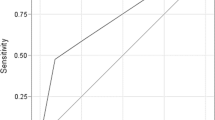Abstract
Goals of work
This is a prospective and observational study comparing the efficacy of risk-assessment models in patients with neutropenic fever in a reference treatment center. The meaning of the complex infection was evaluated.
Materials and methods
Patients were recruited throughout a 9-month period. Inclusion criteria were histologic diagnosis of malignancy, neutropenic febrile secondary to chemotherapy and/or radiotherapy (absolute neutrophil count of <500/µl and axillary temperature ≥38°C), and ≥18 years of age.
Main results
Fifty-three febrile neutropenic patients were included. Twenty one of them were classified as low risk by the Multinational Association of Supportive Care in Cancer (MASCC) risk-index score. The sensitivity, specificity, positive predictive value (PPV), negative predictive value (NPV) and accuracy of the MASCC risk-index scores were, respectively 87.9, 85.0, 90.6, 80.9, and 86.8%. None of the low-risk patients died, but four patients classified as low risk by the MASCC model developed serious medical complications during febrile neutropenic episodes. When we subtracted patients with complex infections from the group of patients with the MASCC risk-index score of ≥21, we got 15 patients that were classified as low risk by a proposed adjustment by complex infection (PACI) model. None of them developed serious medical complications. The sensitivity, specificity, PPV, NPV, and the accuracy of this new model were, respectively, 100, 75.0, 86.8, 100, and 90.6%.
Conclusion
The MASCC risk-index score had high sensitivity and specificity to predict the absence of complications, but the PACI model was better than MASCC for predicting the absence of complications in this febrile neutropenic patients.

Similar content being viewed by others
References
Chamilos G, Bamias A, Efstathiou E et al (2005) Outpatient treatment of low-risk neutropenic fever in cancer patients using oral moxifloxacin. Cancer 103(12):2629–2635
Cherif H, Johansson E, Bjorkholm M et al (2006) The feasibility of early hospital discharge with oral antimicrobial therapy in low risk patients with febrile neutropenia following chemotherapy for hematologic malignancies. Haematologica 91(2):215–222
Donowitz GR, Maki DG, Crnich CJ, et al (2001) Infections in the Neutropenic Patient - New Views of an Old Problem. In: ANNUAL MEETING OF THE AMERICAN SOCIETY OF HEMATOLOGY, 43TH., 2001, Orlando. Education Program Book: Hematology (Am Soc Hematol Educ Program):113–139
Elting LS, Rubenstein EB, Rolston KV et al (1997) Outcomes of bacteremia in patients with cancer and neutropenia: Observations from two decades of epidemiological and clinical trials. Clin Infect Dis 25(2):247–259
Escalante CP, Weiser MA, Manzullo E et al (2004) Outcomes of treatment pathways in outpatient treatment of low risk febrile neutropenic cancer patients. Support Care Cancer 12(9):657–662
Hughes WT, Armstrong D, Bodey GP et al (2002) 2002 guidelines for the use of antimicrobial agents in neutropenic patients with cancer. Clin Infect Dis 34(6):730–751
Kern WV (2006) Risk assessment and treatment for low-risk patients with febrile neutropenia. Clin Infect Dis 42(4):533–540
Klastersky J, Paesmans M, Rubenstein EB et al (2000) The Multinational Association for Supportive Care in Cancer risk index: A multinational scoring system for identifying low-risk febrile neutropenic cancer patients. J Clin Oncol 18(16):3038–3051
Nijhuis CO, Kamps WA, Daenen SM et al (2005) Feasibility of withholding antibiotics in selected febrile neutropenic cancer patients. J Clin Oncol 23(30):7437–7444
Paesmans M (2000) Risk factors assessment in febrile neutropenia. Int J Antimicrob Agents 16(2):107–111
Sipsas NV, Bodey GP, Kontoyiannis DP (2005) Perspectives for the management of febrile neutropenic patients with cancer in the 21st century. Cancer 103(6):1103–1113
Rolston KV (2003) Oral antibiotic administration and early hospital discharge is a safe and effective alternative for treatment of low-risk neutropenic fever. Cancer Treat Rev 29(6):551–554
Rolston KV (1999) New trends in patient management: Risk-based therapy for febrile patients with neutropenia. Clin Infect Dis 29(3):515–521
Talcott JA, Finberg R, Mayer RJ et al (1988) The medical course of cancer patients with fever and neutropenia. Clinical identification of a low-risk subgroup at presentation. Arch Intern Med 148(12):2561–2568
Uys A, Rapoport BL, Anderson R (2004) Febrile neutropenia: a prospective study to validate the Multinational Association of Supportive Care of Cancer (MASCC) risk-index score. Support Care Cancer 12(8):555–560
Acknowledgement
We are indebted to all members of the Departments of Medical Oncology and Internal Hematology of the Felicio Rocho Hospital.
Author information
Authors and Affiliations
Corresponding author
Rights and permissions
About this article
Cite this article
de Souza Viana, L., Serufo, J.C., da Costa Rocha, M.O. et al. Performance of a modified MASCC index score for identifying low-risk febrile neutropenic cancer patients. Support Care Cancer 16, 841–846 (2008). https://doi.org/10.1007/s00520-007-0347-3
Received:
Accepted:
Published:
Issue Date:
DOI: https://doi.org/10.1007/s00520-007-0347-3




